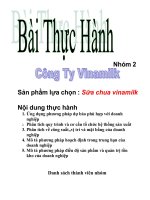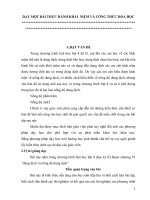Accounting bài thực hành
Bạn đang xem bản rút gọn của tài liệu. Xem và tải ngay bản đầy đủ của tài liệu tại đây (1.25 MB, 26 trang )
<span class="text_page_counter">Trang 1</span><div class="page_container" data-page="1">
<b>TABLE OF CONTENT</b>
LO3: Interpret financial statement...2
1. Profitability ratio...2
a. Gross profit ratio...2
b. Net profit ratio...2
c. Return on capital employment...2
d. Return on equity...2
2. Efficiency ratio...3
a. Inventory turnover ratio...3
b. Assets turnover ratio...3
c. Account receivable collection period...3
d. Account payable payment period...3
3. Solvency ratio...3
As for Short-term solvency...3
a. Solvency ratio...3
b. Quick ratio...3
As for Long-term solvency...3
a. Equity to total assets...3
b. Gearning ratio...3
c. Interest coverage ratio...3
4. Shareholder investment ratio...4
a. Expense...4
b. Price earning ratio...4
c. Dividend cover ratio...4
CACULATION OF RATIO ANALYSIS...5
Gross profit ratio...5
Net profit ratio...5
Return on capital employment ratio...5
Return on equity ratio...5
Inventory turnover Ratio...5
Assets turn over ratio...6
Account receivable collection period...6
Account payable payment period...6
Salary Ratio...6
</div><span class="text_page_counter">Trang 2</span><div class="page_container" data-page="2">Gearing Ratio...7
Interest Coverage Ratio...7
Earning per share...7
Price Earning Ratio...8
Dividend cover ratio...8
LO4: Budgets for planning, control and decision-making using spreadsheets...9
1. Budget and budgeting process...9
The overhead budget...14
Budgeting for variable costs...14
The cost of goods sold budget...15
Budget gross profit...15
Budget contribution margin...16
Material price variance...18
Material cost variance...18
Labor rate variance...18
Labor efficiency variance...18
Labor cost variance...18
Cost variance...18
Sales price variance...19
Sale volume variance...19
Sales variance...19
Profit variance...19
</div><span class="text_page_counter">Trang 3</span><div class="page_container" data-page="3">CONCLUSION...21 REFERENCES...22
</div><span class="text_page_counter">Trang 4</span><div class="page_container" data-page="4">The author will learn about the notion of Financial Statement Interpretation and its components in this essay. Combine with mathematical tasks to comprehend the process of Financial Statement Interpretation. Then, discover budget kinds and how an accountant creates and implements them. Budgeting requires the use of calculating formulae. Finally, learn about variance analysis in accounting, which uses different variances to help accountants efficiently regulate cash flow. Also, apply the algorithm to the exercise and brainstorm potential explanations of the variance.
</div><span class="text_page_counter">Trang 5</span><div class="page_container" data-page="5"><b>LO3: Interpret financial statement</b>
Interpret financial statement is a process analysis financial statement by the way using table Ratio analysis with 4 process caculation to compare to financial statement year ago help business have policies conform with company: profitability ratio, efficiency ratio, solvency ratio and shareholder investment ratio.
Profitability ratio Efficiency ratio Solvency ratio Shareholder investment ratio It is regarded as one of the
foundations for managers to make financial or investment decisions in order to ensure the business's profitability or easier to say ability of firm to make profit.
It assists management in better managing the firm through the use of credit, inventories and company assets.
It means “Ability to pay debts”. This ratio measures the enterprise's capacity to pay its long-term debts.
“ It provides guidence to shareholders for their dicision”
<b>1. Profitability ratio includes four formulas: gross profit ratio, net profit ratio, return on capital</b>
employment and return on equity.
<b>a. Gross profit ratio = </b>Grossprofit
Sales <sup> x 100% = ___% (if the answer higher than the original</sup> comparison time, it is good and vice versa)
<b>b. Net profit ratio = </b>Netincome
Sales <sup> x 100% = ___% (if the answer higher than the original comparison</sup> time, it is good and vice versa)
<b>c. Return on capital employment =</b>Operatingprofit
Equity <sup> x 100% =___ % (if the answer higher than the</sup> original comparison time, it is good and vice versa)
<b>d. Return on equity = </b>Netincome
Equity <sup> x 100% = ___% (if the answer higher than the original</sup> comparison time, it is good and vice versa)
</div><span class="text_page_counter">Trang 6</span><div class="page_container" data-page="6">receivable collection period and account payable payment period.
<b>a. Inventory turnover ratio = </b>Costof goodssold
Closinginventory<sup> = ___times (if the answer higher than the original</sup> comparison time, it is good and vice versa which mean you are more productive)
<b>b. Assets turnover ratio = </b> Sales
Totalassests<sup> = ___times (if the answer higher than the original</sup> comparison time, it is good and vice versa which mean you are more productive)
<b>c. Account receivable collection period =</b>Accountreceivable
Sales <sup> x 365 = ___days (if the answer higher</sup> than the original comparison time, it is bad and vice versa which means you spent less day than requirement)
<b>d. Account payable payment period = </b> Accountpayable
Costof goodssold<sup>x 365= ___days (if the answer higher</sup> than the original comparison time, it is good and vice versa which means you spent less day than requirement)
<b>3. Solvency ratio’s Short-term solvency includes two formulas: solvency ratio and quick ratio.</b>
Long-term solvency includes three formulas: Equity total assets, gearning ratio and interest coverage ratio.
<b>As for Short-term solvencya. Solvency ratio = </b> Currentassets
Currentliability<sup> (if the answer higher than the original comparison time, it is</sup> good and vice versa)
<b>b. Quick ratio = </b> Quickassets
Currentliability<sup>(if the answer higher than the original comparison time, it is good</sup> and vice versa)
<b>As for Long-term solvency</b>
<b>a. Equity to total assets = </b> Totalquity
totalequity+totaldebts <sup>x 100% = ___% if the answer higher than the</sup> original comparison time, it is good and vice versa)
<b>b. Gearning ratio = </b> Totaldebts
Totalquity+totaldebts<sup> x 100% = ___% if the answer higher than the original</sup> comparison time, it is good and vice versa)
</div><span class="text_page_counter">Trang 7</span><div class="page_container" data-page="7"><b>c. Interest coverage ratio = </b>Operatingincome
Interestexpense <sup> = ___times (if the answer higher than the original</sup> comparison time, it is good and vice versa which mean you are more active)
</div><span class="text_page_counter">Trang 8</span><div class="page_container" data-page="8">guidance for shareholders so that they can make appropriate investment decisions. There are 3 formulas to calculate the shareholder's investment ratio: Expense, price earning ratio, dividend cover ratio.
<b>a. Expense = earning per share = </b> Netincome
Number of commonshare<sup> = ___ per share (if the answer higher</sup><sup>£</sup> than the original comparison time, it is good and vice versa)
<b>b. Price earning ratio = </b>Market price pershare
Expense <sup> = ___times (if the answer higher than the original</sup> comparison time, it is good and vice versa which mean you are more productive)
<b>c. Dividend cover ratio = </b> Expense
Dividendpershare <sup> = ___times (if the answer higher than the original</sup> comparison time, it is good and vice versa which mean you are more productive)
</div><span class="text_page_counter">Trang 9</span><div class="page_container" data-page="9"><b>CACULATION OF RATIO ANALYSIS</b>
<b>Gross profit ratio</b>Gross profit ratio of 2021 is 32% has decreased by 1% compared to 2020 which is bad evolution.
<b>Net profit ratio</b>
Return on capital employment of 2020 is 9.26% and has increased significantly in 2021 with 11.6% which is good evolution
<b>Return on equity ratio</b>
Inventory turnover Ratio in 2020 reached 5.7 times and grew significantly to 7.2 times which is good evolution
</div><span class="text_page_counter">Trang 10</span><div class="page_container" data-page="10">Sales/total assets 2.56 times 2.51 times Bad
Assets turn over ratio in 2020 reached 2.56 times and decreased slightly in 2021 at 2.51 times which
Account receivable collection period in 2020 reached 51,9 times and was bad compared to 2020 because account receivable collection period increased significantly in 2021 reaching 59.7 times which is bad evolution
<b>Account payable payment period</b>
Account payable payment period in 2020 reaches 57,6 times and is bad compared to 2020 due to a sharp increase in account payable payment term in 2021 reaching 66.78 times which is bad evolution
Salary Ratio in 2020 reached 2.08 times and decreased slightly in 2021 at 1.97 times which is bad evolution
</div><span class="text_page_counter">Trang 11</span><div class="page_container" data-page="11">Quick Ratio in 2020 reaches 1.457times and slightly increases in 2021 at 1.5 times which is good
Gearing Ratio in 2020 is at 44.34% and reached bad due to gearing ratio for increased in 2021 at 45.68% which is bad evolution
<b>Interest Coverage Ratio</b>
</div><span class="text_page_counter">Trang 12</span><div class="page_container" data-page="12"><b>Price Earning Ratio</b>
Price Earning Ratio for 2020 is 1.375 times, in 2021 has plummeted to 0.86 times, showing a bad earnings multiplier for the year which is bad evolution
<b> Dividend cover ratio </b>
Dividend cover ratio for 2020 is 2.41 times and has decreased slightly to 2.25 times in 2021, showing that dividend payout ratio is at a bad level for the year which is bad evolution
</div><span class="text_page_counter">Trang 14</span><div class="page_container" data-page="14"><b>2. Types of budgets</b>
<b> </b>
<b>Budgeted Gross Profit = Sales Budget - COGS budget</b>
<b>Budgeted Margin Contribution = sales budget - (Material budget + Labor Budget + Variable</b>
<b>Sales budget = Sales units x selling price per unit</b>
(The revenue that company want to make)
<b>Productionbudget</b>
<b>MATERIAL BUDGET</b>
Finished Goods (F.G) * Material required per F.G
Total material require * Price per quantity
Material budget
<b>LABOR BUDGET</b>
Finished Goods (F.G) * Labor hour required per F.G
Total labor require hours * Labor rate per hours
</div><span class="text_page_counter">Trang 15</span><div class="page_container" data-page="15"><b>CACULATION OF BUDGETING</b>
<b>Sales budget for easier to understand we can say the money that the firm hopes to generate. Because</b>
expenses are proportional to sales volume, the sales budget serves as the foundation for all other
The first quarter's sales budget was £9460000, while the second quarter's budget was £10750000. It demonstrates that revenue climbed considerably in the second quarter compared to the first. Sales fell in the second and third quarters owing to pricing changes, with sales of £6750000 in the third quarter. Revenue climbed significantly in the fourth quarter compared to the third quarter, reaching £12375000, the greatest in all four quarters.
<b>Production budget is the next stage of sales budget, it represents the quantity and responsibilities of </b>
the production manager. This ensures sufficient production to meet sales demand and maintains
</div><span class="text_page_counter">Trang 16</span><div class="page_container" data-page="16">increased to 24000 pieces of finished products in the second quarter. The final product level was only 16250 units in the third quarter, but it grew to 28750 units in the fourth quarter, the highest level in four quarters.
<b>Material budget is the amount of raw material consumed in accordance with the production needs </b>
plan. Materials must be obtained at the budgeted price, and inventory levels must be considered.
Material Budget = Per units*Material required per Finished Goods*Price per quanity Quarter 1 (components R) = 18500*4*6 = 444000 units
Quarter 2 (components R) = 24000*4*6 = 576000 units Quarter 3 (components R) = 16250*4*6 = 390000 units Quarter 4 (components R) = 28750*4*6 = 690000 units Quarter 1 (components T) = 18500*3*2 = 111000 units Quarter 2 (components T) = 24000*3*2 = 144000 units Quarter 3 (components T) = 16250*3*2 = 97500 units Quarter 4 (components T) = 28750*3*2 = 172500 units
Total Material Budget (components R) = Quarter 1 + Quarter 2 + Quarter 3 + Quarter 4 = 21000000 units
Total Material Budget (components T) = Quarter 1 + Quarter 2 + Quarter 3 + Quarter 4 = 5250000 units
The materials budget for product R was £444000 in the first quarter and £111000 for product T in the second quarter, increasing to £576000 for product R and £144000 for product T. The materials budget for product R was cut to £390000 in the third quarter and £97500 in the fourth quarter, but by
</div><span class="text_page_counter">Trang 17</span><div class="page_container" data-page="17"><b>Labor budgets are calculations of the labor hours required by the department to create the intended </b>
items. Calculating labor expenses will assist the management in developing a reasonable wage based on the budget in the plan.
Total labor budget = Quarter 1+ Quarter 2+ Quarter 3+ Quarter 4 = 3201750 units
The labor budget was £666000 in the first quarter, climbed by 864000 in the second quarter, and fell to £585000 in the third quarter. Labor's fourth-quarter budget was £1086750, the highest in four quarters.
</div><span class="text_page_counter">Trang 18</span><div class="page_container" data-page="18">to the planned production schedule. To prevent losing budget control, these generic costs must be
The first and second quarters have a higher overhead budget than the third quarter. The lowest was in the third quarter, at £162500, and the greatest was in the fourth quarter, at £287500.
<b>Budgeting for variable costs is calculated per direct labor hour.</b>
</div><span class="text_page_counter">Trang 19</span><div class="page_container" data-page="19">Quarter 4 = 10 * 28750 = 287500
Total variable overhead = Quarter 1 + Quarter 2 + Quarter 3 + Quarter 4 = 875000 units
Variable overhead was £185,000 in the first quarter and climbed dramatically to £240000 in the second quarter. The third quarter has the lowest variable expenses at £162500, while the fourth quarter has the highest at £287500.
<b>The cost of goods sold budget is the total budget that comprises the labor, materials, and overhead </b>
Material budget component R has a cost of goods sold of £2100000, whereas Material budget component T has a cost of goods sold of £525000. The cost of items sold in the Labor budget is £3201750, which is more than the price in the Material budget. Finally, the Cost of products sold in the Overhead budget is £955000.
<b>Budget gross profit is the budget in which the entire sales budget is subtracted from the total </b>
budgets of the material budget, labor budget, and overhead budget, or all three, also known as the cost of products sold.
Budget gross profit = Sales budget - Cost of goods sold = 39335000 - 6781750 = 32553250
</div><span class="text_page_counter">Trang 20</span><div class="page_container" data-page="20">that has been subtracted from the sales budget. After sales budget minus variable overhead, material budget of components R and T, and lastly labor budget, the budget contribution margin is £32633250.
</div><span class="text_page_counter">Trang 21</span><div class="page_container" data-page="21"><b>3. Variance analysis</b>
Variance analysis is the difference between the actual results and the expected results. Also known as the actual performance measurement method where we rely on 2 results "standard result" and "actual result" to compare, when a result is available, if the "standard result" is better we can conclude that the result is favorable, otherwise if the "actual result" is better then we can conclude that the result is unfavorable
<b>Profit variance</b>
The gap between actual and budgeted profit is referred to as profit variance. A profit variance is deemed positive if the actual profit exceeds the projected profit. If the actual profit is smaller than the predicted profit, the profit variance is deemed unfavorable.
<b>Cost variance</b>
The difference between the planned amount for a campaign and the actual amount spent after the campaign is concluded is referred to as cost variance.
<b>Sales variance</b>
The gap between actual and expected sales is referred to as sales variance.
<b>Material variance</b>
The difference between the actual price paid for raw materials and the expected budgeted price is known as material variance. Capturing raw material pricing will make it easier to budget for resources and track production expenses.
<b>Labor variance</b>
The gap between actual and predicted labor expenses is measured by labor rate variance.
Standard result better Favorable (F)
Actual result better Unfavorable (U)
</div><span class="text_page_counter">Trang 22</span><div class="page_container" data-page="22">When the actual overhead incurred differs from the projected amount, the overhead variance occurs. The overall cost variance has various further variations. Each of these variations pertains to a different part of total spending.
<b>CACULATION OF VARIANCE</b>
<b>COST VARIANCE</b>
<b>Material price variance</b>Material price variance = (Standard price - Actual price) * Actual quantity = (11-11.9)*715 = 643.5 U
(It is unfavorable because the result is a negative number)
<b>Material unit variance</b>
Material unit variance = (Standard quantity - Actual quantity)* Standard price = (650-715)*11 = 715 U
(It is unfavorable because the result is a negative number)
<b>Material cost variance (1)</b>
Material cost variance = Material price variance + Material unit variance = 643.5 U + 715 U = 1358.5 U
(It is unfavorable because the result is a negative number)
<b>Labor rate variance</b>
Labor rate variance = (Standard rate - Actual rate) * Actual hour = (3.25 – 4.8) * 2400 = 3720 U
(It is unfavorable because the result is a negative number)
<b>Labor efficiency variance</b>
Labor efficiency variance = (Standard hour - Actual hour)*Standard rate = (1700 - 2400) *3.25 = 2275 U
(It is unfavorable because the result is a negative number)
<b>Labor cost variance (2)</b>
Labor cost variance = Labor rate variance + Labor efficiency variance = 3720 U + 2275 U = 5995 U
(It is unfavorable because the result is a negative number)
From (1) and (2) we have
<b>Cost variance</b>
<b>Cost variance = Material cost variance + Labor cost variance + Overhead cost variance </b>
= 1358.5 U + 5995 U +0 = 7353.5 U
</div>







